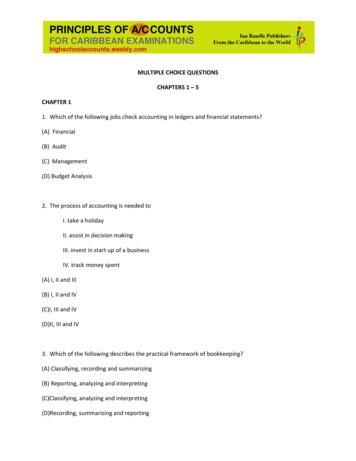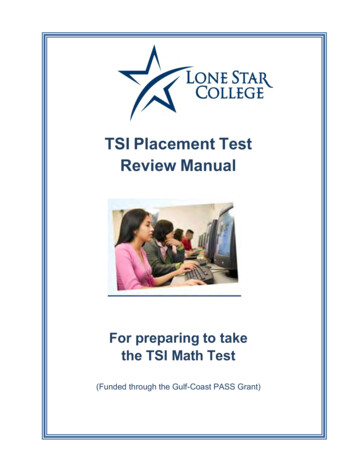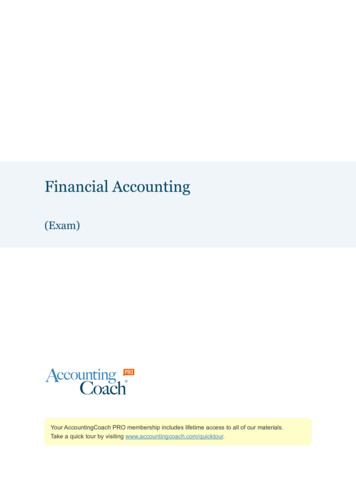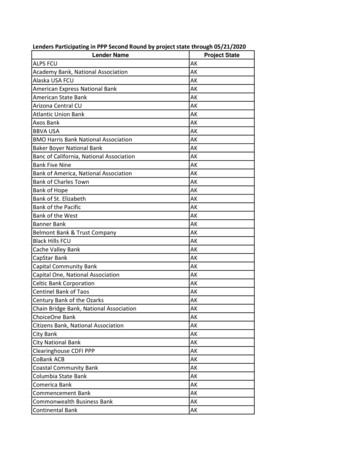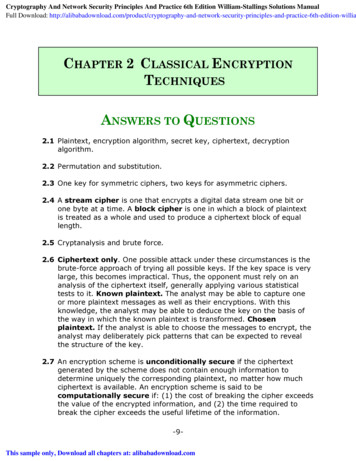
Transcription
Cryptography And Network Security Principles And Practice 6th Edition William-Stallings Solutions ManualFull Download: tion-williaCHAPTER 2 CLASSICAL ENCRYPTIONTECHNIQUESANSWERS TO QUESTIONS2.1 Plaintext, encryption algorithm, secret key, ciphertext, decryptionalgorithm.2.2 Permutation and substitution.2.3 One key for symmetric ciphers, two keys for asymmetric ciphers.2.4 A stream cipher is one that encrypts a digital data stream one bit orone byte at a time. A block cipher is one in which a block of plaintextis treated as a whole and used to produce a ciphertext block of equallength.2.5 Cryptanalysis and brute force.2.6 Ciphertext only. One possible attack under these circumstances is thebrute-force approach of trying all possible keys. If the key space is verylarge, this becomes impractical. Thus, the opponent must rely on ananalysis of the ciphertext itself, generally applying various statisticaltests to it. Known plaintext. The analyst may be able to capture oneor more plaintext messages as well as their encryptions. With thisknowledge, the analyst may be able to deduce the key on the basis ofthe way in which the known plaintext is transformed. Chosenplaintext. If the analyst is able to choose the messages to encrypt, theanalyst may deliberately pick patterns that can be expected to revealthe structure of the key.2.7 An encryption scheme is unconditionally secure if the ciphertextgenerated by the scheme does not contain enough information todetermine uniquely the corresponding plaintext, no matter how muchciphertext is available. An encryption scheme is said to becomputationally secure if: (1) the cost of breaking the cipher exceedsthe value of the encrypted information, and (2) the time required tobreak the cipher exceeds the useful lifetime of the information.-9This sample only, Download all chapters at: alibabadownload.com
2.8 The Caesar cipher involves replacing each letter of the alphabet withthe letter standing k places further down the alphabet, for k in therange 1 through 25.2.9 A monoalphabetic substitution cipher maps a plaintext alphabet to aciphertext alphabet, so that each letter of the plaintext alphabet mapsto a single unique letter of the ciphertext alphabet.2.10 The Playfair algorithm is based on the use of a 5 5 matrix ofletters constructed using a keyword. Plaintext is encrypted two letters ata time using this matrix.2.11 A polyalphabetic substitution cipher uses a separatemonoalphabetic substitution cipher for each successive letter ofplaintext, depending on a key.2.12 1. There is the practical problem of making large quantities of randomkeys. Any heavily used system might require millions of randomcharacters on a regular basis. Supplying truly random characters inthis volume is a significant task.2. Even more daunting is the problem of key distribution andprotection. For every message to be sent, a key of equal length isneeded by both sender and receiver. Thus, a mammoth keydistribution problem exists.2.13 A transposition cipher involves a permutation of the plaintextletters.2.14 Steganography involves concealing the existence of a message.ANSWERS TO PROBLEMS2.1 a. No. A change in the value of b shifts the relationship betweenplaintext letters and ciphertext letters to the left or right uniformly,so that if the mapping is one-to-one it remains one-to-one.b. 2, 4, 6, 8, 10, 12, 13, 14, 16, 18, 20, 22, 24. Any value of a largerthan 25 is equivalent to a mod 26.c. The values of a and 26 must have no common positive integer factorother than 1. This is equivalent to saying that a and 26 are relativelyprime, or that the greatest common divisor of a and 26 is 1. To seethis, first note that E(a, p) E(a, q) (0 p q 26) if and only ifa(p – q) is divisible by 26. 1. Suppose that a and 26 are relativelyprime. Then, a(p – q) is not divisible by 26, because there is no wayto reduce the fraction a/26 and (p – q) is less than 26. 2. Suppose-10-
that a and 26 have a common factor k 1. Then E(a, p) E(a, q), ifq p m/k p.2.2 There are 12 allowable values of a (1, 3, 5, 7, 9, 11, 15, 17, 19, 21, 23,25). There are 26 allowable values of b, from 0 through 25). Thus thetotal number of distinct affine Caesar ciphers is 12 26 312.2.3 Assume that the most frequent plaintext letter is e and the second mostfrequent letter is t. Note that the numerical values are e 4; B 1; t 19; U 20. Then we have the following equations:1 (4a b) mod 2620 (19a b) mod 26Thus, 19 15a mod 26. By trial and error, we solve: a 3.Then 1 (12 b) mod 26. By observation, b 15.2.4 A good glass in the Bishop's hostel in the Devil's seat—twenty-onedegrees and thirteen minutes—northeast and by north—main branchseventh limb east side—shoot from the left eye of the death's head— abee line from the tree through the shot fifty feet out. (from The GoldBug, by Edgar Allan Poe)2.5 a. The first letter t corresponds to A, the second letter h corresponds toB, e is C, s is D, and so on. Second and subsequent occurrences of aletter in the key sentence are ignored. The resultciphertext:plaintext:SIDKHKDM AF HCRKIABIE SHIMC KD LFEAILAbasilisk to leviathan blake is contactb. It is a monoalphabetic cipher and so easily breakable.c. The last sentence may not contain all the letters of the alphabet. Ifthe first sentence is used, the second and subsequent sentences mayalso be used until all 26 letters are encountered.2.6 The cipher refers to the words in the page of a book. The first entry,534, refers to page 534. The second entry, C2, refers to column two.The remaining numbers are words in that column. The names DOUGLASand BIRLSTONE are simply words that do not appear on that page.Elementary! (from The Valley of Fear, by Sir Arthur Conan Doyle)-11-
2.7 ITDSFTIYOTUSRUNVSEEIEADRTBEHIFOETOHTETALHMETb. The two matrices are used in reverse order. First, the ciphertext islaid out in columns in the second matrix, taking into account theorder dictated by the second memory word. Then, the contents ofthe second matrix are read left to right, top to bottom and laid out incolumns in the first matrix, taking into account the order dictated bythe first memory word. The plaintext is then read left to right, top tobottom.c. Although this is a weak method, it may have use with time-sensitiveinformation and an adversary without immediate access to goodcryptanalysis (e.g., tactical use). Plus it doesn't require anythingmore than paper and pencil, and can be easily remembered.2.8 SPUTNIK-12-
2.9 PT BOAT ONE OWE NINE LOST IN ACTION IN BLACKETT STRAIT TWOMILES SW MERESU COVE X CREW OF TWELVE X REQUEST RENABDFGHI/JKLMPQSTVWXYZb.2.11 a. UZTBDLGZPNNWLGTGTUEROVLDBDUHFPERHWQSRZb. UZTBDLGZPNNWLGTGTUEROVLDBDUHFPERHWQSRZc. A cyclic rotation of rows and/or columns leads to equivalentsubstitutions. In this case, the matrix for part a of this problem isobtained from the matrix of Problem 2.10a, by rotating the columnsby one step and the rows by three steps.2.12 a. 25! 284b. Given any 5x5 configuration, any of the four row rotations isequivalent, for a total of five equivalent configurations. For each ofthese five configurations, any of the four column rotations isequivalent. So each configuration in fact represents 25 equivalentconfigurations. Thus, the total number of unique keys is 25!/25 24!2.13 A mixed Caesar cipher. The amount of shift is determined by thekeyword, which determines the placement of letters in the matrix.-13-
2.14M13P16T20a. We need an even number of letters, so append a "q" to the endof the message. Then convert the letters into the correspondingalphabetic 21h8c3a1e5k11l12r18q17The calculations proceed two letters at a time. The first pair:! C ! ! ! ! # 1 & # 9 4 &# 13 & mod 26 # 137 & mod 26 # 7 &# C2 & " 5 7 %" 5 %" 22 %" 100 %"%The first two ciphertext characters are alphabetic positions 7 and 22,which correspond to GV. The complete MFWWUQRKRb. We first perform a matrix inversion. Note that the determinate of theencryption matrix is (9 7) – (4 5) 43. Using the matrixinversion formula from the book: 1! 9 4 ! 161 92 ! 5 12 ! 7 4 1 ! 7 4 #& #&mod 26 #&&mod 26 23#&mod 26 #43 " 5 9 %" 5 9 %" 5 7 %" 115 9 %" 15 25 %Here we used the fact that (43)–1 23 in Z26. Once the inversematrix has been determined, decryption can proceed. Source:[LEWA00].-14-
2.15 Consider the matrix K with elements kij to consist of the set of columnvectors Kj, where:! k k1n# 11K # ## k knn" n1 && and&&%! k# 1jKj # # k# nj" &&&&%The ciphertext of the following chosen plaintext n-grams reveals thecolumns of K:(B, A, A, , A, A) K1(A, B, A, , A, A) K2:(A, A, A, , A, B) Kn2.16 a.b.c.d.e.f.g.h.i.7 1347 13413410 13424 13224 (132 – 1) 1337648235301572482.17 a. (80 – 10) mod 26 18b. [(1 9 5) (7 2 1) (22 4 2) – (22 9 1) – (2 2 1)– (5 7 4)] mod 26 (45 14 176 – 198 – 4 – 140) mod 26 (–107) mod 26 232.18 We label the matrices as A and B, respectively.a. det(A) (44 – 3) mod 26 15(det(A))–1 7, using Table E.1 of Appendix E" cof A cof A %11 ( )21 ( ) 'A 1 ( det ( A )) 1 cof ( A ) cof ( A ) '1222#&" 24 5 %" 22 3 %" 154 –21 %7 ''mod 26 'mod 26 # 1 2 &# 7 14 &# 19 14 &-15-
b. det(B) [(6 16 15) (24 10 20) (1 13 17) –(1 16 20) – (10 17 6) – (15 24 13)] mod 26 (1440 4800 221 – 320 – 1020 – 4680) mod 26 441 mod 26 25We use the formulas from Appendix E( )( )cofji Kb ij mod 26 17 cof Kjidet Kb11 16 10 25mod 26 (16 15 10 17) 25mod 26 5100 mod 26 817 1524 1 25mod 26 – ( 24 15 1 17) 25mod 26 –8575mod 26 517 15b12 24 1 25mod 26 ( 24 10 1 16 ) 25mod 26 5600 mod 26 1016 10b13 b21 b22 b23 b31 b32 –b33 ( ) mod 2613 10 25mod 26 – (13 15 10 20 ) 25mod 26 125mod 26 2120 156 1 25mod 26 ( 6 15 1 20 ) 25mod 26 1750 mod 26 820 156 1 25mod 26 ( 6 10 1 13) 25mod 26 1175mod 26 2113 1013 16 25mod 26 (13 17 16 20 ) 25mod 26 2475mod 26 2120 176 24 25mod 26 – ( 6 17 24 20 ) 25mod 26 9450 mod 26 1220 176 24 25mod 26 ( 6 16 24 13) 25mod 26 5400 mod 26 813 16! 8 5 10 #&B-1 # 21 8 21 &# 21 12 8 &"%2.19 key:legleglegleplaintext: explanationciphertext: PBVWETLXOZR-16-
Cryptography And Network Security Principles And Practice 6th Edition William-Stallings Solutions ManualFull Download: 18Se41923Xe42125Zd31215Pe4812Md347Hb.c2251B2.21 your package ready Friday 21st room three Please destroy thisimmediately.-17This sample only, Download all chapters at: alibabadownload.com
-9- CHAPTER 2 CLASSICAL ENCRYPTION TECHNIQUES ANSWERS TO QUESTIONS 2.1 Plaintext, encryption algorithm, secret key, ciphertext, decryption algorithm. 2.2 Permutation and substitution. 2.3 One key for symmetric ciphers, two keys for asymmetric ciphers. 2.4 A stream cipher is one that encrypts a digital data stream one bit or one byte at a time. A block cipher is one in which a block of plaintext




